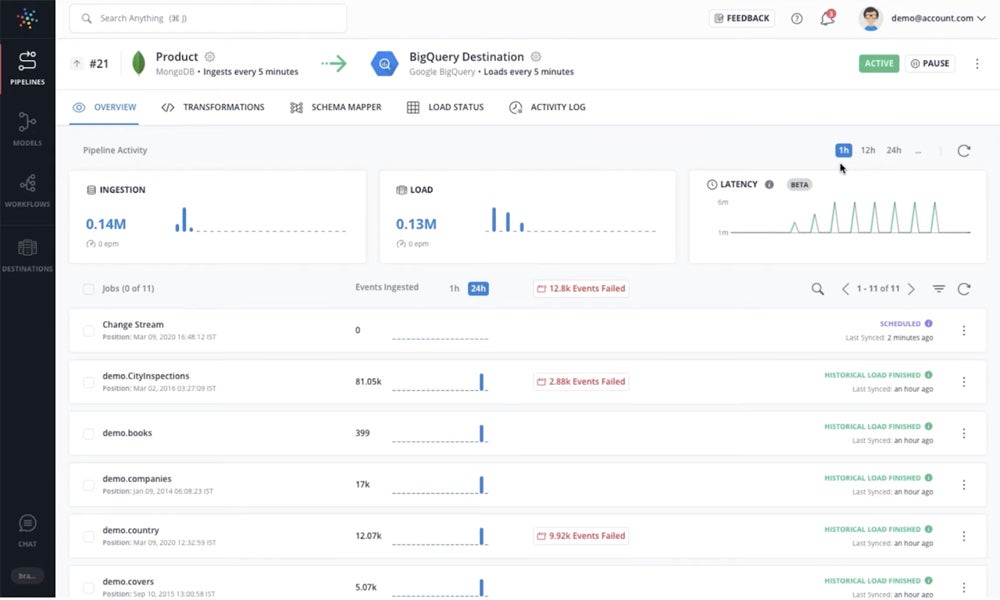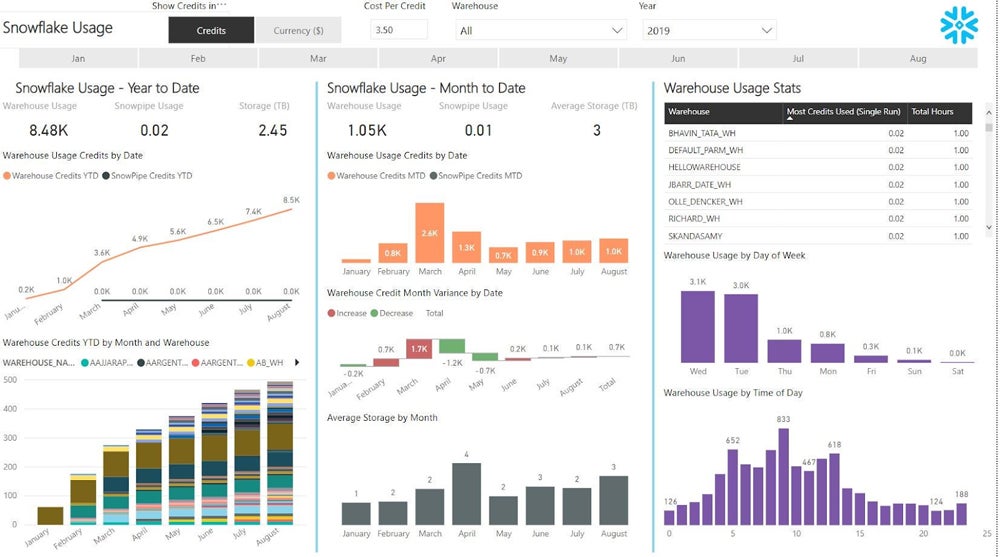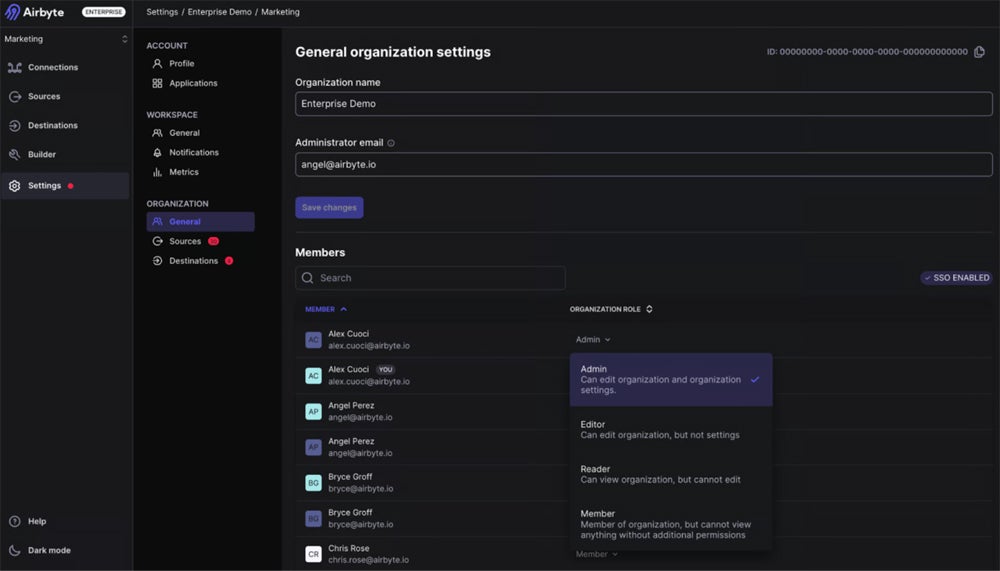Cloud data management software is a set of tools that organizes and manages data across several cloud platforms. It ensures that data is accurate, secure, and compliant throughout its lifecycle. A reliable cloud data management solution enables data sharing across on-premises and cloud storage that increases business intelligence initiatives. To help you select a suitable solution, I evaluated the top market solutions and identified their use cases.
Here are the six best cloud data management software and solutions:
- Informatica: Best overall cloud data management software
- Hevo Data: Best option for customer service and support
- NetApp BlueXP: Best for hybrid and multi-cloud environments
- Rubrik: Best for data security and industry standard compliance
- Snowflake: Best for third-party tools integration and support
- Airbyte Cloud: Best for ease of use and administration
Top Cloud Data Management Software Comparison
This table provides a summary of cloud data management solutions, including their essential features and the availability of free plans and trials.
| Big Data Management | Data Quality Management | Zero-ETL | Free Plan | Free Trial | |
|---|---|---|---|---|---|
| Informatica | ✔️ | ✔️ | ✔️ | ✔️ | 30 days |
| Hevo Data | ✔️ | ✔️ | ✔️ | ✔️ | 14 days |
| NetApp BlueXP | ✔️ | ✔️ | ❌ | ❌ | 30 days |
| Rubrik | ✔️ | ✔️ | ❌ | ❌ | Contact sales |
| Snowflake | ✔️ | ✔️ | ✔️ | ❌ | 30 days |
| Airbyte Cloud | ✔️ | ✔️ | ✔️ | ❌ | 14 days |
✔️=Yes ❌=No/Unclear
All of the solutions listed here excelled in specific categories, but Informatica emerged as our overall winner, with its wide range of core capabilities plus a free plan offering. Continue reading to learn about each solution’s features, pros and cons, and alternatives, or see how I evaluated each top solution below.
Informatica – Best Overall Cloud Data Management Software
Overall Rating: 4/5
- Core features: 4.8/5
- Pricing and transparency: 3.5/5
- Data security: 4/5
- Cloud data governance and compliance: 3.5/5
- Customer support: 3.8/5
- Ease of use and administration: 4.1/5
Informatica, an AI-powered cloud data management solution, tops our list with a broad product portfolio focusing on data integration, quality, cataloging, and governance. It combines data from multiple sources to enable seamless analysis and reporting. Informatica provides thorough extract, transform, and load (ETL) capabilities to ensure effective data warehousing. It’s most suitable for enterprises looking for a feature-rich and versatile data management solution.

Pros
Cons
Hevo Data – Best Option for Customer Service & Support
Overall Rating: 3.9/5
- Core features: 4.3/5
- Pricing and transparency: 3.4/5
- Data security: 3.5/5
- Cloud data governance and compliance: 4.2/5
- Customer support: 4.2/5
- Ease of use and administration: 4.3/5
Hevo Data, an automated zero-maintenance data platform, unifies data from over 150 sources in near real time via an easy-to-use no-code user interface. Its fault-tolerant architecture ensures 100% data correctness, 99.9% uptime, and fast system alarms — all backed by responsive 24/7 customer assistance and a five-minute response time via Live Chat support. Hevo uses models and workflows to quickly make data analytics-ready.

Pros
Cons
NetApp BlueXP – Best for Hybrid & Multi-Cloud Environments
Overall Rating: 3.8/5
- Core features: 4.1/5
- Pricing and transparency: 2.2/5
- Data security: 4.3/5
- Cloud data governance and compliance: 4.7/5
- Customer support: 3.5/5
- Ease of use and administration: 4.5/5
NetApp BlueXP, formerly NetApp Cloud Data Sense, uses AI-powered technologies to improve data governance in hybrid and multi-cloud systems. It provides a SaaS-based unified control plane to enhance your visibility and control. BlueXP unifies data services and provides a flexible, secure infrastructure with robust AIOps capabilities, making it best for navigating complicated hybrid and multi-cloud landscapes.

Pros
Cons
Rubrik – Best for Data Security & Industry Standard Compliance
Overall Rating: 3.8/5
- Core features: 4.3/5
- Pricing and transparency: 1.2/5
- Data security: 4.7/5
- Cloud data governance and compliance: 5/5
- Customer support: 3.9/5
- Ease of use and administration: 4.3/5
Rubrik, a key player in data security and compliance, largely focuses on cyberattack prevention through comprehensive backup, data protection, threat analytics, and cyber recovery solutions for different infrastructures and cloud environments. Its encryption capabilities ensure data integrity and regulatory compliance. These are backed up by secure coding methods and independent verification of compliance, security, and privacy requirements.

Pros
Cons
Snowflake – Best for Third-Party Tools Integration & Support
Overall Rating: 3.7/5
- Core features: 4.5/5
- Pricing and transparency: 3/5
- Data security: 4/5
- Cloud data governance and compliance: 3.4/5
- Customer support: 2.7/5
- Ease of use and administration: 4.3/5
Snowflake specializes in third-party tool integration and support, providing a scalable data cloud platform for application development, data warehousing, and lakes. It offers unified security, governance, and metadata management, which reduces ETL complexity. Snowflake also works with leading data management partners to ensure smooth integration and improve data consistency across analytics projects from various sources.

Pros
Cons
Airbyte Cloud – Best for Ease of Use & Administration
Overall Rating: 3.6/5
- Core features: 4.5/5
- Pricing and transparency: 2.7/5
- Data security: 3.2/5
- Cloud data governance and compliance: 4.5/5
- Customer support: 2.4/5
- Ease of use and administration: 4.5/5

Pros
Cons
Top 5 Features of Cloud Data Management Software
The best cloud data management software come with features such as zero-ETL capabilities, which allow for seamless data integration without the need for traditional ETL processes. They also feature powerful tools for handling massive amounts of data, incorporate AI for quick data extraction, enable disaster recovery to provide data resilience, and provide full data quality management to assure accuracy and reliability throughout the data lifecycle.
Zero ETL
Zero-ETL is a new approach in which data is integrated in real-time or near-real-time, minimizing the period between data collection and availability for analysis. Transformation occurs during querying, which eliminates the need for staging locations. This strategy allows enterprises to evaluate and query data straight from the source, increasing efficiency by avoiding traditional, time-consuming ETL operations.
Big Data Management
Big data management entails organizing, administering, and managing massive amounts of structured and unstructured data. It enables businesses and governments to manage terabytes to petabytes of data saved in multiple formats. It uses centralized interfaces to manage data resources, improve outcomes, ensure security, and increase analytics using efficient cycle procedures and visualization approaches while allowing multiple concurrent users.
AI Integration
Integrating AI into data management software means strategically deploying AI that enhances data quality and analytics. It includes techniques for efficiently collecting, organizing, storing, and utilizing data while assuring its integrity, accessibility, security, and compliance. It facilitates automation to improve data handling, easily support regulatory compliance, and accelerate processes to enable informed decision-making.
Disaster Recovery
Disaster recovery services in data management ensure business continuity and resilience. They include developing backup systems, storing data off-site, and providing redundancy to reduce the impact of system failures. These safeguards protect against unforeseen disruptions and data loss, allowing activities to resume swiftly without extended downtime.
Data Quality Management
Data quality management ensures accuracy and reliability by integrating data collection, enhanced processing, and effective delivery. It takes administrative oversight to ensure data integrity, which is required for consistent and reliable data analysis. High-quality data is critical for generating actionable insights and assuring the precision of information utilized in your decision-making and strategic planning.
How I Evaluated the Best Cloud Data Management Software
I created a scoring rubric to evaluate the top cloud data management solutions based on six fundamental criteria. Each criterion has specific subcriteria or features listed under it. Then, I assessed if the product meets the specific features or services listed. Based on their scores per criterion, I determined each solution’s use case. Ranking their overall scoring, I identified the best six solutions, with the top scorer as our overall winner.
Evaluation Criteria
In my assessment, I prioritized the core characteristics necessary in evaluating cloud data management software. Next, I looked into their pricing and transparency and data security capabilities. I reviewed their cloud compliance and data governance to ensure regulatory compliance. Finally, I assessed customer assistance, ease of use, and administration to determine the user experience and operational efficiency.
- Core features (25%): Include zero ETL, big data management, data distribution, file sharing, disaster recovery, data quality control, unlimited storage for scalability, and AI integration for advanced analytics and automation.
- Criterion winner: Informatica
- Pricing and transparency (20%): Considers aspects like free trials, price structures, transparent pricing information, availability of free plans or tiers, free demos, and data egress fees.
- Criterion winner: Informatica
- Data security (20%): Covers additional security elements like cloud security policies, risk assessments, threat analysis, IAM integration, encryptions, endpoint security, and more.
- Criterion winner: Rubrik
- Cloud data governance and compliance (15%): Reviews the conduct of internal and external audits, resource and service governance, and adherence to key industry standards.
- Criterion winner: Rubrik
- Customer support (10%): Assesses the availability of support platforms like live chat, phone, and email assistance, manuals, demos, training, and user reviews to assess customer service quality.
- Criterion winner: Hevo Data
- Ease of use and administration (10%): Evaluates the UI, centralized management console, intuitive functionalities, workflow integrations, CSP maintenance, and user reviews for ease of use.
- Criterion winner: Airbyte Cloud
Frequently Asked Questions (FAQs)
What Are the Common Challenges in Using Cloud Data Management Software?
Using cloud data management software might present issues, such as data egress prices imposed by providers when transferring or restoring data, which are designed to discourage data removal. Also, despite the cloud’s cost-effective brand, keeping huge amounts of data in cloud data lakes or databases can be expensive. This can affect your budgeting and data management techniques.
What’s the Difference Between Cloud Data Management & Traditional Data Management?
Traditional data management relies on on-premise hardware and IT infrastructure, which limits scalability and increases upfront expenses. Cloud data management makes use of cloud platforms to enable dynamic scalability, improved disaster recovery, and flexible data access without requiring large infrastructure expenditures to boost data agility.
What Are the Common Compliance Standards in Securing Cloud Data?
Here are some of the key data compliance regulations and standards for securing cloud data:
- SOC 1: Focuses on internal controls over financial reporting.
- SOC 2: Evaluates data security, availability, integrity, confidentiality, and privacy.
- HIPAA: Protects health information privacy and security.
- GDPR: Safeguards EU residents’ personal information.
- CCPA: Provides Californians with control over their personal information.
- PCI DSS: Ensures the secure handling of credit card information.
- ISO/IEC 27001: Governs information security.
- FedRAMP: Standardizes security for cloud services that interact with federal agencies.
Bottom Line: Securely Manage Your Cloud Data
Cloud data management makes data handling easier for both organizations and individuals. It maintains huge volumes of data on the cloud, adjusting to changing business needs with a diverse set of software and technologies available. When choosing the best solution, align your business needs with the software features, then take advantage of its free trials or plans to test its functionalities to make sure it seamlessly fits your business operations.
Employ a cloud security posture management (CSPM) tool to add another layer of security to your cloud data management solution.










